Tin
Before development of the Wilga base metal mine in 1992, tin, antimony and silver were the only metals other than gold to be mined in Victoria, and then only as by-products of gold mining. About 11,250 tonnes of tin concentrate have been produced in Victoria; more than 80% of the historical tin production came from the Beechworth Eldorado district.
Tin ore is exclusively in the form of cassiterite (SnO2). It has been worked in 18 fields in Victoria and its presence has been reported at numerous other localities. Production has come mainly from placer deposits in the northeast of the State, derived from primary deposits associated with S-type granites.
Cassiterite is normally disseminated throughout these granites but can be concentrated in lode deposits in late-stage magmatic bodies such as greisens and pegmatites. Weathering and erosion has further concentrated tin in extensive alluvial deposits.
Victoria's largest tin field is at Reedy Creek in the Beechworth Eldorado district, where tin was recovered as a by-product of alluvial gold mining. Estimated production from this field is approximately 9,200 tonnes of tin.
Other significant alluvial tin deposits are at Koetong, Mount Cudgewa, and Victoria's second most productive tinfield at Toora in south Gippsland, which produced more than 400 tonnes of tin between 1892 and 1940.
Most exploration for tin has been in two areas of northeastern Victoria, where rocks of the high-grade Omeo Metamorphic Complex are intersected by swarms of pegmatite, greisen and other felsic dykes. Both areas are near the southern end of a productive tin field in New South Wales associated with emplacement of Silurian granites.
Other areas of significance for tin are the Mitta Mitta and Mount Wills tin fields, both of which were worked sporadically in the early 1900s. There is also lode tin associated with the formation of the Omeo Metamorphic Complex at Burrowye and Mount Alfred, and at the most recently developed lode tin mine at Walwa.
Further information
Minerals of Victoria – Geological Survey of Victoria Report 92
Tin deposits of Victoria – Geological Survey of Victoria Bulletin 60
Maps
To create your own maps online and in real time, plan exploration activities by viewing land status, or download GIS data to add to your own maps, visit GeoVic.

Page last updated: 12 Jan 2023